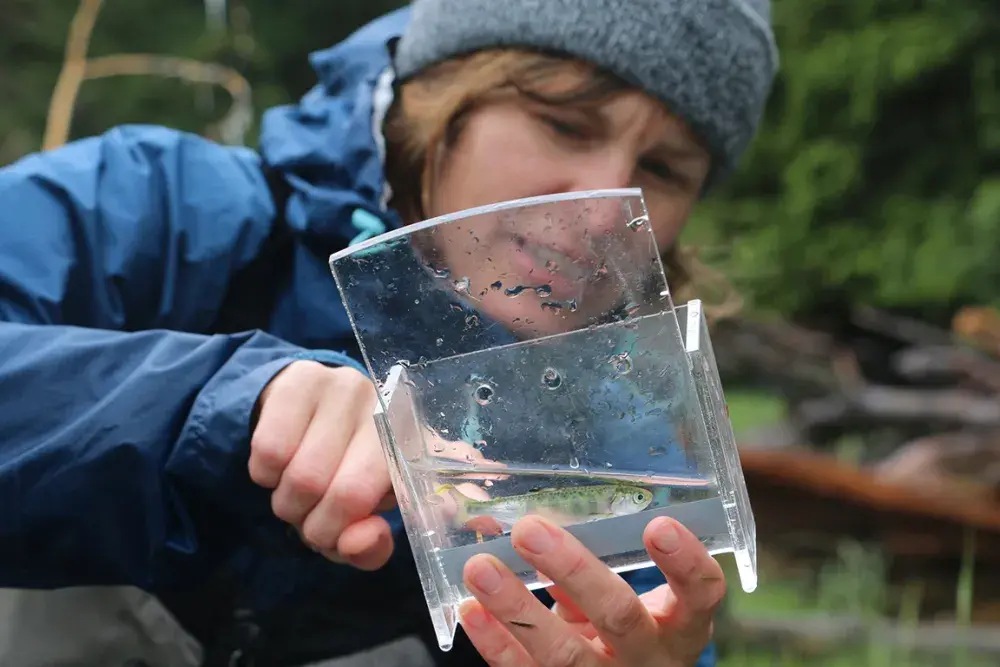Flowing west from the Vancouver Island Interior Mountain Range and emptying into Bedwell Sound to the north of Meares Island, the Bedwell River or Oinimitis, its original Nuu-chah-nulth name, is the subject of a juvenile salmon assessment led by Ahousaht First Nation and funded under the Aboriginal Fund for Species at Risk (AFSAR) program.
The aim of the multi-year study is to better understand threats to wild chinook on the west coast of Vancouver Island.
To gather the data, Ahousaht fisheries manager and technicians assisted by Uu-a-thluk biologists and fisheries assessment staff at DFO, are using a number of methods to trap and assesses chinook fry and smolts, such as mark and recapture, pole seining in-river, beach seining in the estuary, and a Rotary Screw Trap (RST) in the lower river to determine health, condition and relative abundance of Bedwell chinook smolts migrating to the ocean.
The assessment is also monitoring and recording juvenile chinook habitat use to define where and when chinook smolt productivity is being limited the most.
“We’re looking at the weight vs. length to examine the overall health of smolts and fry in the Bedwell,” said Candace Picco, Uu-a-thluk biologist for the Central Region. “And we’re analyzing data for food availability, food choices and the impact on chinook health.”
Researchers are assessing stomach content to indicate the estuary’s capacity to support the chinook population.
“The stomach contents give us an idea of the preferred prey from the spectrum of food available to smolts and the difference between foods available inside eelgrass beds vs. outside eelgrass beds,” said Picco.
By analyzing the salmon species caught in different habitats around the estuary, the researchers found chum use the eelgrass beds more than other species like chinook and coho that prefer gravel beds. The assessment is helping to determine whether Bedwell chinook smolt health is being limited by the river or estuary conditions and if they are getting a healthy start to life.
Monitoring and recording how smolts use their habitats also helps to determine where and when in the life cycle productivity falls short. “If it’s at the smolt stage of the life cycle then we can work to decrease these limitations early on,” said Jared Dick, Uu-a-thluk associate biologist.
So far results from the study show that chinook smolts are staying in the river for longer than previously thought. This new information is making it all the more important to identify how the conditions in estuaries and rivers influence the smolts.
Potential threats resulting from habitat loss and poor habitat conditions in the estuary and river include deforestation, warming temperatures, competition with larger hatchery juveniles, and impacts from fish farms.
From the early 1990s through to the early 2000s, wild chinook populations on the west coast of Vancouver Island declined considerably. With a focus on conserving declining chinook populations and their habitats in Ahousaht traditional territory, the Ahousaht Smolt Assessment Study is part of a broader evaluation of threats and limiting factors to help WCVI wild chinook populations eventually recover and support chinook fisheries again in Ahousaht Ha-houlthee.
By determining whether Bedwell chinook productivity is being limited in the river or estuary, Ahousaht First Nation fisheries staff and its partners could begin to address these lacks through habitat restoration projects, working with hatcheries to decrease competition with wild fish, and mitigating the effects of fish farms.
“If the smolt phase is productive and smolts migrating to the ocean are healthy then we can focus efforts on mitigating limiting factors for the juvenile and/or adult phases,” said Candace Picco.







